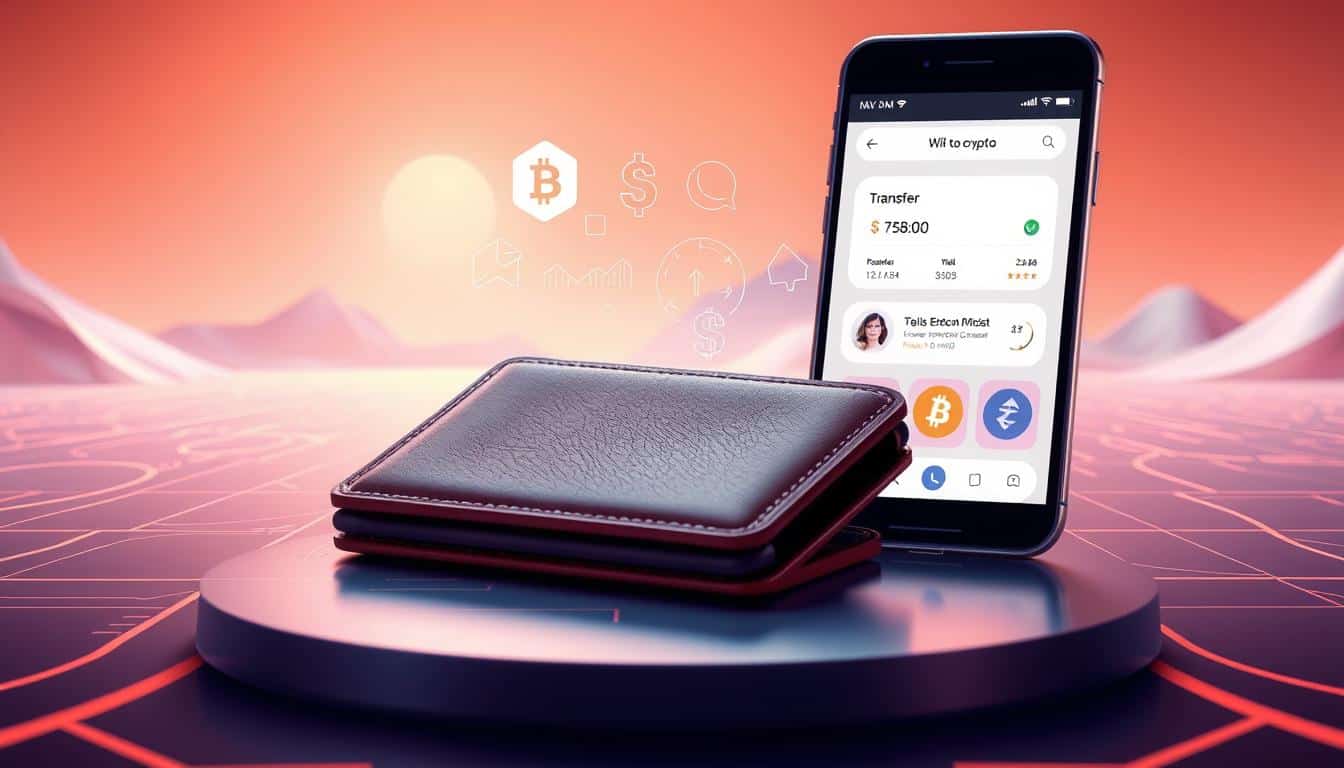Over 60% of new crypto enthusiasts start by using a fiat gateway. This fact is crucial for understanding transfers. If mastering fiat-to-crypto transfers is your goal, choosing the right gateway is key.
I’ve explored wallets like Coinbase Wallet, Binance Wallet, Crypto.com Wallet, and Trust Wallet. I looked into various methods: ACH or SEPA for inexpensive bank transfers, cards, and PayPal for quick transactions, and crypto ATMs for immediate purchases. A good guide to cryptocurrency wallet transfers starts with ensuring your platform supports your preferred payment methods.
From my testing, I’ve found an effective step-by-step method: first, ensure your wallet approves your fiat method. Then, compare methods like bank transfers or cards. Check the supported cryptocurrencies next. Finally, test with a small amount to avoid mistakes and high fees.
Key Takeaways
- Confirm your wallet or exchange supports a fiat gateway before attempting a fiat to crypto wallet transfer.
- Bank transfers (ACH, SEPA, SWIFT) are usually cheapest; card and payment apps are faster but cost more.
- Popular wallets like Coinbase Wallet and Crypto.com offer integrated fiat on-ramps and extra features like spending cards.
- Run a small test transfer to validate the rails, tokens, and security settings before moving larger sums.
- Use this cryptocurrency wallet transfer guide to match the rail (speed vs. cost) to your priorities.
Understanding Fiat-to-Crypto Transfers
When you swap dollars for Bitcoin, what exactly happens? Government money and digital tokens follow different paths. This has a big effect when moving fiat to crypto using wallets.
Fiat currency comes from the government, like the U.S. dollar. It’s not backed by gold or anything. The Federal Reserve and other central banks control its amount. They use tools like setting interest rates. Over time, things like inflation change what money can buy. To make it simple, when you move money into a crypto platform, it’s still fiat until traded for digital currency.
What Is Cryptocurrency?
Cryptocurrencies are secure digital tokens recorded on a digital ledger. Bitcoin and Ethereum are popular ones. Others, like Cardano and Ripple, have their own rules. To buy these, you often need a place that takes money or cards. Not all places let you deposit money directly; some need you to already have cryptocurrency.
The Importance of Wallets in Transfers
Wallets are crucial for crypto transactions. They can be controlled by a company like Coinbase or by you with apps like Trust Wallet. Many include ways to add money from your bank. Services like Coinbase Wallet and others make converting money to crypto easy.
Let me guide you through a typical transfer from bank to crypto. First, money goes from your bank to an exchange. Then, the exchange puts crypto in your wallet. The type of wallet, how you add money, and the wallet’s design affect your experience. This shows why the choice of wallet is important for easy fiat-to-crypto transfers.
| Element | What it Means | Typical Examples |
|---|---|---|
| Fiat Rail | How government money moves into platforms | ACH, wire transfer, debit/credit card |
| Crypto Rail | Blockchain networks that record token ownership | Bitcoin, Ethereum, Cardano |
| Custody Model | Who controls private keys and funds | Custodial (Coinbase) vs self-custodial (Trust Wallet) |
| On-Ramp Support | Whether wallets/exchanges accept fiat deposits | Coinbase Wallet, Crypto.com, Binance |
| User Experience | Ease, speed, fees, and KYC steps | Instant card buys, slower ACH, wire fees |
| Common Use Case | Typical flow from bank to crypto | Bank → Exchange → Wallet; or Bank → Wallet with fiat on-ramp |
This guide simplifies fiat-to-crypto transfers. It shows the main choices people face. Knowing about different currencies and wallets makes transfers smoother and less surprising.
Types of Wallets for Cryptocurrency
Over the years, I’ve shifted money between regular currency and cryptocurrencies. Figuring out the different kinds of wallets was key. Each wallet type changes how fast, costly, and safe your money moves between forms.
Hot Wallets: Pros and Cons
Hot wallets are used on devices that connect to the internet. With apps like Coinbase Wallet, Trust Wallet, and Exodus, you can get coins quickly using a card or bank. They make buying and using crypto easy for everyday transactions.
But there’s a downside. Hot wallets face more risks like hacks because they’re online. When exchanges keep your keys in custodial hot wallets, things are faster, but you lose some control.
Cold Wallets: Pros and Cons
Cold wallets don’t connect to the internet. Tools like Ledger and Trezor keep your keys safe offline. Experts often suggest using these for storing large amounts without worry.
Yet, cold wallets can’t take paper money directly. You need to transfer from an online spot, which slows things down. They’re best for keeping your crypto safe over time, not for quick swaps.
Choosing the Right Wallet for You
Your choice should reflect how much risk you can handle and how you plan to use your crypto. I keep a bit in a hot wallet for quick buys and more on a Ledger for security. This way, I get both speed and safety.
New users should start with a hot wallet that’s easy to feed with regular money, using services like MoonPay. To learn more before choosing, check out this guide on the best crypto wallet options.
Also, think about who holds the keys. Holding your own keys in a self-custodial wallet means you’re in full control. With custodial services, though easier, make sure they’re well protected.
Most folks find a blend works best. Use a hot wallet for small, regular transactions and a cold one for big, long-term savings. This strategy makes daily use smooth and keeps big amounts secure.
How to Choose the Right Fiat-to-Crypto Exchange
I’ve been doing this for years, turning dollars into digital coins and back. The choice of exchange made a huge difference. Here, I’ll guide you through the key points, popular U.S. platforms, and the safety checks I do.
Factors to Consider
First, check how you can put money in. Does it take ACH, wires, or cards? ACH saves money but takes time. Cards are faster but pricier. For those outside the US, see if it works with SEPA or SWIFT.
Next, look at fees and how long things take. It’s not just about the cost of buying and selling. Find out the fees for putting in and taking out money through wallets or accounts. This way, there are no shockers.
See which currencies you can buy and how easily you can buy a lot. For niche coins, pick somewhere with lots of buyers and sellers. This makes trading big amounts smoother.
Popular Exchanges in the U.S.
Coinbase is where many in the U.S. start. It’s easy and works well with U.S. money. Binance.US offers lots of choices with good fees. Crypto.com is great for getting rewards and using a crypto card.
There are pros and cons to each service. I like ones that let me move my crypto to my own wallet without a fuss. This makes changing wallets easy after I switch my money into crypto.
Security Features to Look For
Make sure they follow U.S. laws and have strong KYC/AML rules. This lessens the risk of them disappearing suddenly.
Check if they keep money safe offline, insure your assets, and get checked by auditors. Things like two-factor authentication, specific withdrawal lists, and secure login must be offered.
Having good support and clear fees is crucial. When issues arise, easy help and knowing the costs beforehand helps a lot. The best exchanges are secure yet easy to talk to.
- Practical checklist: USD options, straightforward fees, secure storage, insurance, 2FA, safe withdrawals, reliable support.
- Personal rule: If it’s a hassle to move my crypto to my personal wallet, I pass.
Steps to Perform a Fiat-to-Crypto Transfer
I’ll show you how to turn your dollars into crypto. You’ll learn to set up a wallet, choose an exchange, and make the trade. Think of this as your go-to guide for your first fiat to crypto transfer.
Setting Up Your Wallet
Pick between a custodial and a self-custody wallet. Custodial wallets like Coinbase Wallet or Binance Wallet are linked to exchanges and usually require KYC. Self-custody options like Exodus or Ledger need you to back up a seed phrase and keep it safe.
With self-custody, I make a paper backup of the seed, store it safely, and try recovering it on another device. It’s crucial for safely transferring your wallet.
Selecting an Exchange
Choose an exchange that fits your needs. In the U.S., I look at Coinbase, Kraken, and Binance.US for USD transactions. ACH transfers are cheaper but slower; card payments are faster but come with higher fees.
Make sure the exchange works with your wallet. Some allow you to buy crypto directly in the app, which simplifies the process.
Executing the Transfer
Start by completing KYC on your chosen exchange. Then, add funds through ACH, wire transfer, card, or a payment app. Decide on a market or limit order for purchasing your crypto. If you have a self-custody wallet, transfer your coins there and double-check the transaction ID.
Here’s a quick checklist: 1) Select your wallet type and secure your seed phrase; 2) Choose an exchange; 3) Complete KYC; 4) Deposit your fiat funds; 5) Purchase the cryptocurrency; 6) Transfer it to your wallet if needed; 7) Confirm the transaction on the blockchain. Following these steps carefully makes fiat to crypto transfers seamless and error-free.
Graph and Statistics on Crypto Adoption
I look at charts every day, using public feeds from CoinGecko and exchange APIs for accuracy. The increase in ways to buy crypto — like bank transfers and payment apps — is obvious in the data. But, crypto ATMs are mostly in big cities, not everywhere.
Comparing exchange rankings and features from Coinbase, Binance, Crypto.com, Trust Wallet, Exodus, and BitPay, patterns show up. Wallets are making it easier to use money directly, with Visa cards and swapping in-app. This ease of use is predictably leading to more users and transactions.
The trends that are important are these:
- Wallets are making it easier to use your money, helping people decide to use them.
- Stores and companies using crypto wallets for payments and paying workers are increasing.
- Support from big institutions and clear U.S. rules are influencing exchange products.
My charts tell me that making things easier leads to more people using crypto. Every payment option added makes the graph go up. But, fees and rules still slow things down. Predictions show smoother use and more options will encourage more people and money moving into crypto.
To help understand these trends, I compare wallet features and their likely impact.
| Wallet / Platform | Fiat On-Ramp Type | Key Feature | Expected 5-Year Impact |
|---|---|---|---|
| Coinbase | Bank transfer, card | In-app fiat rails, OTC for institutions | Higher retail and institutional flow through integrated rails |
| Binance | Card, payment partners | Wide currency support, local payment integrations | Significant cross-border fiat-to-crypto volume |
| Crypto.com | Card, bank, debit card | Visa debit integration, merchant tools | Increased merchant acceptance via fiat-enabled wallets |
| Trust Wallet | In-app partners, card | Non-custodial access to fiat rails | Broader retail reach with smoother UX |
| Exodus | In-app swap partners, card | User-friendly design, fiat integrations | Steady growth among DIY users |
| BitPay | Card, merchant tools | Payments and payroll solutions | Higher merchant-side crypto utility |
Here’s what the numbers mean: more ways to buy crypto leads to more activity. I focus on which wallets people can use and how much it costs them. This helps show where most crypto buying and selling might happen.
I’m hopeful but careful with my outlook. Using inputs from CoinGecko and exchange APIs, I spot clear crypto trends. If wallets keep making it easier to buy crypto and rules become clearer, we’ll see more people jumping in.
Common Challenges in Fiat-to-Crypto Transfers
I’ve learned a lot from moving fiat to crypto wallets many times. Transfers can go smoothly, but often there are issues. I want to share these common problems and my solutions.
First off, laws and rules can make things complicated. Not all exchanges handle fiat the same way. In the U.S., they have to follow a lot of rules from different places. This means a lot of steps to follow, slowing things down.
Regulatory Issues in the U.S.
Be ready for lots of checks on your identity. Sometimes you need to do extra paperwork for more features or options. I once waited several days for an exchange to check my money’s source. This wait is a big deal when prices change quickly.
Regulatory issues also pop up when it’s not clear what category a token falls under. Exchanges might stop trades with those tokens until they figure things out. You might have to find another way or wait until trading starts again.
Transaction Fees and Wait Times
Payment methods vary in cost and speed. ACH is often cheaper, sometimes free, but can be delayed by banks. Wire transfers and SWIFT are quicker but cost more. Using cards means paying extra fees.
Services like MoonPay add convenience but at a cost. Crypto ATMs are more expensive. Also, when the network is busy, transaction fees on chains like Ethereum can get very high.
| Method | Typical Cost | Typical Wait Time | Common Pain Points |
|---|---|---|---|
| ACH | Low to free | 1–3 business days | Bank rejects, verification holds |
| Wire / SWIFT | High (tens to hundreds USD) | Same day to 2 days | Bank fees, sender/beneficiary mismatch |
| Credit/Debit Card | Processor fees + 1–5% markup | Instant | High cost, chargeback risk |
| Third-party On-Ramps | Variable; markup common | Instant to minutes | Opaque pricing, limits |
| Crypto ATM | Very high (5–20%+) | Minutes | Limited liquidity, fees |
| Direct Wallet Conversion (on-ramp partner) | Depends on partner + network gas | Minutes to hours | Gas spikes, partner limits |
I always check fees before buying. If fees are high, I split my purchases. Having my accounts pre-verified helps avoid unexpected blocks. These tips help avoid surprises with fees and waiting times.
In the end, think about what you’re willing to deal with. Going cheap can mean waiting longer. Paying more can be faster but may bring extra checks. Knowing all about these transfers and fees can really help when you move money into a wallet.
Frequently Asked Questions (FAQs)
I often talk about my journey of moving money into crypto. You’ll get short answers, actionable steps, and tips from my own experience that saved me both time and money.
How Long Do Transfers Take?
Transfer times can vary. ACH transfers in the U.S. usually take 1–3 business days. Instant ACH partners make funds available right away for some platforms.
Crypto purchases with cards are quick but come with higher fees. SEPA transfers in the Eurozone are fast, usually within a day. SWIFT transfers depend on the bank and intermediaries, leading to possible delays.
Once your crypto is moving on the blockchain, timing varies. Bitcoin transfers can take anywhere from 10 to over 60 minutes. Ethereum transfers are faster or slower depending on the gas price and network demand.
Can You Transfer Fiat from Any Bank?
Some banks may not allow transfers to crypto exchanges. Wells Fargo once stopped my transfer, labeling it high risk.
Regulated exchanges, like Coinbase and Kraken, list their deposit details. Use the account numbers and reference fields they provide. Always check with your bank in advance and reach out to their customer service for unusual transfers.
Doing a small test transfer first is a wise move to ensure everything goes smoothly.
What if My Transfer Fails?
Don’t panic if a fiat transfer doesn’t go through. Keep screenshots, timestamps, and reference numbers handy. These details are very helpful during support calls.
Get in touch with both the bank and the exchange using your transaction reference. For problems on the blockchain, track your transfer with the transaction hash. If you made a mistake with the bank details or crypto address, the exchange might be able to trace or recover deposits. But, getting back crypto sent to the wrong address is tough unless the receiver is a custodial exchange that agrees to help.
Always document your steps and provide all the details to support. If you hit a roadblock, you might need to engage your bank’s fraud team. Try a small transfer first to minimize risks.
For insight into hidden fees and tips to protect your money during transfers, please review hidden crypto wallet fees.
| Scenario | Typical Time | Action If Delayed |
|---|---|---|
| ACH deposit (standard) | 1–3 business days | Check bank confirmation; contact exchange with reference number |
| Instant ACH / instant debit | Seconds to minutes | Verify balance, then buy or withdraw |
| Card purchase | Instant for crypto purchase | Monitor for chargebacks; keep receipt |
| SWIFT international | 1–5 business days, variable | Confirm intermediary banks; share SWIFT reference with exchange |
| On-chain crypto transfer (Bitcoin) | 10–60+ minutes | Check mempool, provide tx hash to support |
| Failed fiat deposit | Varies until resolved | Collect receipts, contact bank and exchange, escalate if needed |
Tools and Resources for Successful Transfers
I have a simple set of tools I use for moving money to crypto. It includes checking fees, what currencies they support, and if they work well with my bank. Doing this prevents unexpected issues and makes moving money easier.
Recommended Wallets
I like using both a custodial wallet for easy purchases and a hardware wallet to save my crypto. Coinbase Wallet and the Coinbase exchange are perfect for small buys because they’re easy to use. Binance is great for more currency options and Crypto.com is good for spending and earns rewards.
I use Trust Wallet on my phone for quick card purchases. Exodus is my choice on the computer because it’s easy to use. For payments, BitPay is still the best. These wallets let me buy, spend, and save my crypto safely.
Trusted Exchange Platforms
Choose exchanges that fit your needs, like supporting local money, low fees, and easy account setup. I look at CoinGecko and other review sites to compare them. They show me the cost and options quickly.
I mainly use Coinbase, Binance, and Crypto.com. They meet my needs for speed, fees, and following rules. This way, I have good options for different situations.
Online Calculators for Crypto Conversion
Before buying, I check the current rates to avoid surprises. Websites like CoinGecko and CoinMarketCap are quick ways to do this. They help me see if I’m getting a good deal.
I also use tools to check fees for sending my crypto. Combining these with a conversion calculator sometimes finds cheaper options. I keep bookmarks for help pages to fix issues fast.
Here’s a quick list I use for choosing tools. It shows what they’re best for, their strengths, and any typical fees or important details. This makes deciding easier.
| Tool | Best For | Notable Strength | Typical Fee/Note |
|---|---|---|---|
| Coinbase Wallet / Coinbase | Beginner buys | Simple bank integration, clear UI | Bank ACH: low; card: higher |
| Binance Wallet / Binance | Liquidity and multi-fiat | Wide fiat rails, deep order books | Competitive maker/taker fees |
| Crypto.com | Spending + rewards | Visa card integration, perks | Card fees vary; rewards offset |
| Trust Wallet | Mobile card purchases | Easy partner on-ramps | Partner fees depend on provider |
| Exodus | Desktop/mobile with on-ramps | User-friendly, noncustodial | Third-party on-ramp fees apply |
| BitPay | Merchant payments, prepaid cards | Business payment flows | Card/program fees vary |
| CoinGecko / CoinMarketCap calculators | Live conversions | Accurate mid-market rates | Free; refresh for live data |
| ETH gas trackers / mempool explorers | Timing on-chain transfers | Real-time fee estimates | Gas varies by congestion |
Evidence and Sources Supporting Crypto Transfers
I look into the real actions behind moving money into crypto. Tools like bank methods, ATMs, and online services are key. Seeing what exchanges say about times and fees also guides me.
Examples from big names like Coinbase and Binance reveal how people start using crypto. Others, like Crypto.com and BitPay, show us the use of crypto in shopping. This shows the full cycle of money in the digital age.
I always have stories of moving money from cash to crypto ready. They highlight how long it takes, security checks, and common errors. These stories help me suggest the best ways to move money safely.
Case Studies of Successful Transfers
The choice of method stands out in these stories. Using ACH on Coinbase is cheaper but slower. Switching to cold wallets through the blockchain is quicker after the exchange sends it.
Information from Trust Wallet, Exodus, and BitPay gives us the specifics. I look at what they charge and outside checks to back up their info. This helps me tell you what to expect in time and money.
Research Reports on Market Growth
Studies from Chainalysis and CoinGecko shed light on the market. Chainalysis tracks money flow. CoinGecko watches how new users get involved and how big the market is.
I also look at overviews like the one on investopedia for the basics on handling and taxes. They sum up rules and the U.S. tax view on crypto.
Summaries on CoinMarketCap and CoinGecko help too. They provide stories and numbers. I use this info to draw a clear picture for you on using crypto, its risks, and its popularity.
| Source Type | What It Shows | Practical Use |
|---|---|---|
| Exchange transparency pages | Fee schedules, fiat on-ramp volumes | Estimate costs and settlement windows |
| Wallet provider docs | Feature lists, supported rails, UX flows | Choose wallet and expected transfer steps |
| Chainalysis / CoinGecko reports | On-chain flows, market capitalization trends | Quantify adoption and growth |
| Industry roundups | Case studies, vendor comparisons | Real-world examples of successful transfers |
Combining my own tests with third-party audits helps me guide you better. This mix offers a detailed view on transferring fiat to crypto in today’s world.
Future Trends in Fiat-to-Crypto Transfers
I’ve been watching the payment world evolve. The future looks more practical than showy. With layer-2 solutions, quicker settlement chains, and bridges that work together, costs are dropping. This means cheaper and faster fiat-to-crypto transfers for us all.
Innovations in Blockchain Technology
Now, wallets are becoming more user-friendly. They’re adding built-in card use, instant crypto buys, and ways to earn interest. On-ramps like Ramp and MoonPay make it easier to get started. Meanwhile, Coinbase, Binance, and Crypto.com are enhancing security and compatibility. For more on how blockchain works, check this introduction to blockchain.
Potential Regulatory Changes
In the U.S., laws will impact how we use crypto. We might see stricter rules on who can use it and how. Plus, there could be new licenses for fiat gateways and more checks on what tokens are. These changes might slow things down at first. But, they’ll lead to a safer and more professional system later on.
The key point? The user experience is getting better without losing security. With lower fees, easier fiat to crypto and back transfers, and wallet cards, there’s more use by shops and big companies. This mix will increase real-world crypto use in the next five years.








